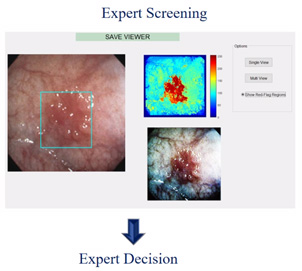The detection of non-polypoid superficial neoplastic lesions using current standard of white light endoscopy surveillance and random biopsy is associated with high miss rate. The subtle changes in mucosa caused by the flat and depressed neoplasms often go undetected and do not qualify for further investigation, e.g., biopsy and resection, thus increasing the risk of cancer advancement. This paper presents a screening tool named the saliency-aided visual enhancement (SAVE) method, with an objective of highlighting abnormalities in endoscopic images to detect early lesions. SAVE is a hybrid system combining image enhancement and saliency detection. The method provides both qualitative enhancement and quantitative suspicion index for endoscopic image regions. A study to evaluate the efficacy of SAVE to localize superficial neoplastic lesion was performed. Experimental results for average overlap index >0.7 indicated that SAVE was successful to localize the lesion areas. The area under the receiver-operating characteristic curve obtained for SAVE was 94.91%. A very high sensitivity (100%) was achieved with a moderate specificity (65.45%). Visual inspection showed a comparable performance of SAVE with chromoendoscopy to highlight mucosal irregularities. This paper suggests that SAVE could be a potential screening tool that can substitute the application of burdensome chromoendoscopy technique. SAVE method, as a simple, easy-to-use, highly sensitive, and consistent red flag technology, will be useful for early detection of neoplasm in clinical applications.

